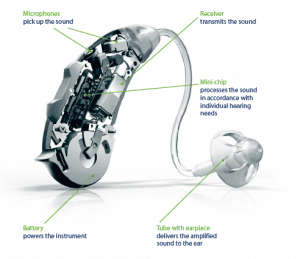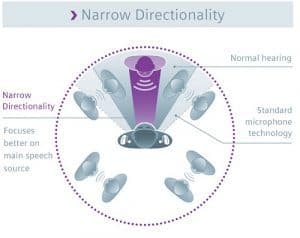The Best Hearing Aids tend to have these features
PLUS a few more niche ones for specialist applications
Time to Read: 25 minutes
- How are you supposed to know which hearing aid features really matter?
- The very best hearing aids should have these three important features
- Multi-Base Automatic Switching – for best automatic performance and less need for manual program changes
- Exceptional Sound Quality – Improved speech clarity, better music enjoyment, and less distortion in loud environments
- That’s not all folks…
Modern hearing aids have many built-in features, some more helpful than others.
The biggest question is which is the best hearing aid for you?
It is hard for the layman to know which features actually make a real difference. There is a lot of marketing out there promoting various features and benefits, which just confuses matters more. Typically more expensive hearing aids have more features, but ironically not all of them matter much.
This is extremely confusing, but let me help clear that up. If you'd like a free copy of the complete Hearing Aid Buyers Companion, which includes this and more information, you can download it at the end of this article.
How are you supposed to know which hearing aid features really matter?
Some features, such as multiple channels, are easy to implement and look impressive on paper, but in reality, don’t make much of a difference in the hearing aid’s actual performance for the average hearing aid user. Interestingly, some smaller manufacturers appear to push these “paperweight” features as they tend to lack in the technically difficult features that really matter most to user benefit. You

often see multiple channels (32, 64, or even 196) advertised as one of the key features of “cheaper” online hearing aids. These aids are often advertised as premium technology at low prices. In reality, Around 8 channels are all you really need for an optimally performing hearing aid. When your hearing is tested, audiologists tend to only measure around 8 frequencies, which roughly correspond with the hearing aid channels. So any more channels than this on a hearing aid are simply extrapolated and not measured data.
This article will reveal which features you should consider having in your next hearing aid to achieve the best possible benefit available today. We have filtered out all the fluff, as well as the features such as effective feedback management, open fitting, Impulse Noise management, Noise reduction, Telecoil, electronic wind noise reduction, etc., which are already well established and expected as a minimum on decent hearing aids.
We have selected three universally applicable important hearing aid features that can really make a difference to a user’s experience.
They are, however, strictly the opinion of the author, who has over 20 years of experience in hearing aid fitting and technology and who has seen the progress of digital hearing aids since their inception.
Note: Your best hearing aid should be chosen, not in isolation, but with the guidance of a good audiologist. Without this guidance, you could end up with a hearing aid that just does not work well.
The very best hearing aids should have these three important features:
Automatic Directional microphones – For better speech understanding in noise
Hearing aids have been able to effectively improve hearing in quiet situations pretty much since their inception. Over the last decade, there really hasn’t been much difference between different hearing aid models’ performance in quiet situations. There are some factors that affect an individual person's ability to hear well with hearing aids, but overall, most proper hearing aids do a great job of optimising hearing in quiet if fit professionally using gold-standard methods such as real-ear measurements.
 A much bigger challenge is improving hearing in noise. In this respect, hearing aids have gradually become more effective in separating the speech you want to hear from the speech you don’t. Each person's ability to hear speech in noise is different, so your needs regarding which technology is right for you can only be determined using comprehensive speech-in-noise testing.
A much bigger challenge is improving hearing in noise. In this respect, hearing aids have gradually become more effective in separating the speech you want to hear from the speech you don’t. Each person's ability to hear speech in noise is different, so your needs regarding which technology is right for you can only be determined using comprehensive speech-in-noise testing.
The only proven way to achieve this is through the use of directional microphones. A modern directional microphone system consists of two microphones on each hearing aid. When the directional microphone system is activated, the hearing aid focuses the direction of sound pick-up forward. This means you hear loudest from the direction you are looking at, whilst sounds next to and behind you are suppressed.
Directional microphones are most effective when they automatically switch when interfering background noise, often other people speaking, is detected. Manual systems only get it right when the user remembers to push the button to switch modes, which unfortunately does not happen consistently. Automatic systems get it right 90%+ of the time as they are analysing the sound hundreds of times a second.
There are several levels of directionality, listed below in order of complexity, from least to the most complex.
Fixed Directionality – Does not alter to follow the sound around you. Instead, it picks up the best in front and the worst right next to you. Has been available for decades. If you move your head the noise level changes based on the fixed pattern. This is normally available in the lowest levels of hearing aid technology and most often require manual switching.
Adaptive Directionality – A little smarter in that it follows the one loudest noise behind you as it moves, notching it out. (Many lower-end hearing aids have at least this level of directionality). This first became available around 20 years ago. This technology is often found in automatically switching hearing aids. This level is perfectly suitable if your hearing in noise is only mildly impaired.
Multi-Band Directionality – Follows multiple sound sources behind you, suppressing them even if they move or you move your head. The number of bands ranges from around 4 up to 48 in some more advanced models. This requires more processing than has been available for the last decade or so. This improves your hearing in noise further and can suit mild to moderate difficulty hearing speech in background noise .
Super Directionality (Beam Forming)– This is the most complex level of Directionality and can offer the best hearing in noise in certain situations like at cocktail parties. Here a hearing aid on one ear wirelessly combines its two microphones with the two on the other ear to form a four-microphone array. This is the latest innovation and has been available in limited brands, first released publicly around 8 years ago.
This provides maximum pickup in a narrow beam in front of the hearing aid user while offering maximum suppression behind the hearing aid user. More modern versions of this can automatically trigger and follow the loud noises behind you. 
Super Directionality is only available in limited brands. Not all models within the brand have this premium feature. Super directionality becomes important for moderate to severe signal-to-noise ratio hearing loss as tested using speech in noise testing.
Note: Directionality requires hearing aid microphones to be spaced at least 9 mm apart to be effective. For this reason, it tends to be available only in hearing aids with sufficient space to house the microphones. So as a rule, they are not available in Completely-in-the-canal (CIC) or Invisible-in-the-canal (IIC) hearing aids. These small hearing aids tend to compromise functionality for size. The exception is Signia's latest Silk and CIC devices, which wirelessly connect the two single microphones in each hearing aid (Left and right) to form a directional microphone with two microphones. The directionality is not as good as with two microphones but is better than nothing. I would say it gets close to the performance of a Fixed Directional microphone but is still far from ideal. This simulated directionality would only suit the mildest of signal-to-noise ratio hearing losses.
NOTE: The better a hearing aid’s directionality, the more expensive it tends to be. Not everyone requires the most expensive hearing aid with top-end directionality to do well, however. It all depends on how much support your brain requires. Too little support and you may be quite frustrated in noise. Too much support and there may be a chance of your brain getting "lazy" (More research is required on this latter aspect, but limited early data suggests this may be a possibility). The only way to know is to undergo a speech-in-noise test and have your score matched to a hearing aid’s performance in noise. You can read more here about improving your hearing in noise
It is also critical you work with the hearing aid to get the most out of its directional microphones. Basically, keep noise to your back and the person you are listening to, to your front. We have an article detailing tips and tricks to get the most out of your hearing aids in background noise..
Update: Oticon has once again altered the way hearing aids work in noise with the introduction of its More range of hearing aids. These hearing aids offer only very basic directionality to emulate the shape of the ear. Instead, they use a brand new Neural Noise reduction technique using advanced onboard artificial intelligence to analyse a sound scene in real-time and focus on sounds that are important to the user. The user feedback has been very positive, so watch this space as this has the potential to change the way hearing in noise is addressed going forward.
Multi-Base Automatic Switching – for best automatic performance and less need for manual program changes
This one is likely to cause a bit of controversy as most Hearing Aid brands DON’T offer this feature. The reason for this goes back to the early days of digital hearing aids when it was technically very difficult to create a multi-base automatic hearing aid without some serious performance issues. Most manufacturers chose single-base automaticity as the foundation of their digital strategy. A brave few chose the more complex multi-base automatic system as their foundation.
To understand Multi-Base Automaticity, you first need to understand its counterpart, Single-Base Automaticity. Single-Base Automaticity means that the hearing aid, which is essentially a computer dealing with sound, has a single set of features active for its automatic program based on a few core settings like compression (how it deals with different levels of sound) and frequency response (how it corrects for your hearing at the different pitches).
When an environment is encountered requiring an automatic change, those underlying strategies stay the same, but adaptive features like noise reduction or directionality are increased or decreased.
A big advantage of this approach was that it was relatively easy to do without causing any noticeable switching effects to the end user. The big disadvantage is that if a setting required any underlying changes to the core processing, such as those required for music, then a manual program would need to be used for optimal performance.
Another limitation to the clinician would be that if a client has issues in one situation that is automatically adapted for e.g. background noise, they were left with one of two choices.
They could either change the noise settings and hope that all the other situations will remain acceptable, or they would have to create a manual program to address that single situation. This essentially means that the hearing aid is semi-automatic. More manual programs often mean more confusion as the user has to figure out which setting is best for any given situation, which distracts from the conversation you are trying to have at the same time.
Multi-Base Automaticity essentially switches the hearing aid automatically from one set of core features to another (Automatic program switching). So not only can the adaptive features change, but the frequency response and core compression characteristics can change automatically. This approach is much more automatic than single-base systems.
In the past, the biggest disadvantage was that hearing aid users could hear the hearing aid switch from one program to another, which was quite unsettling. With each generation, hearing aids become ever faster and now new strategies, like the blending of programs, gradually gotten rid of the side effects altogether. Today you can experience smooth transitions with optimal automatic functioning without compromise.
The biggest advantages of modern Multi-Base Automatic hearing aids are that each automatic program can be changed independently of any other. This means, if you have difficulties hearing in noise, the clinician can confidently change only that program without any concern for changes to programs that are working well. The clinician also has very little need to add manual programs, which in turn means less manual fiddling from you, the user.
Availability of Multi-Base Automaticity:
Phonak (Sonova)
Unitron (Sonova)
Hansaton (Post Sonova Acquisition models)
Why don’t other manufacturers just switch to Multi-Base Automaticity?
Most manufacturers tend to build on features from their previous generation hearing aids. This means that the next generation of hearing aid has all the features of the previous one PLUS MORE. To change to a completely new core digital strategy would mean that much of what was done previously would have to be discarded, and they would likely have to start everything from scratch. They basically have too much to lose as they have to learn or license what they don’t know about making Multi-Base Automaticity work effectively. They also run the risk of alienating the clinicians who are used to the way things have always been done in the past.
Some manufacturers like Siemens (now Signia) have tweaked their Single-Base Automatic system to allow a change to the frequency response and a few other criteria in its automatic settings, which is an improvement on other Single-Base Automatic systems. They do not however allow the full flexibility of a true Multi-Base automatic system and manual programs are still required at times.
Update: Real-time artificial intelligence on the hearing aid has the potential to change the way hearing aids react to different environments, negating the benefit of multi-base Automaticity. We are starting to see applications of this e.g. Oticon's More range of hearing aids. Phonak also has some AI in its AutoSense automatic system.
Exceptional Sound Quality – Improved speech clarity, better music enjoyment, and less distortion in loud environments
Digital Hearing aids have always had pretty good sound quality, but over the last 48 months, we have seen some impressive advancements in how sound is captured and processed in these miniature computers.
In the past, limitations in size, power usage, and processing ability, limited the range of sound input that could be processed in a hearing aid. The limited resources available then were focused on speech audibility at the cost of sound quality.
This is all starting to change, however. Big manufacturers have gradually been updating their hearing aid ranges with much more powerful processing, allowing them to deal with a wider range of incoming sounds. This greatly improves their sound quality, especially for music. It also means less distortion in very loud environments.
The top-rated manufacturers regarding sound quality are in no particular order:
- Widex
- Starkey
- Phonak
- Unitron
- Hansaton (Post Sonova Acquisition models)
- Oticon
- Signia
- GN Resound
- Bernafon
- Sonic Innovations
That covers the top three features I believe one should consider as must-haves in your next hearing aid. A combination of the features is better than any single one on its own through. Saying that most modern hearing aids are far removed from their older siblings in terms of performance and quality. This is because the chips driving hearing aids are basically computers dedicated to sound. A 5-year-old computer cannot perform as well as a modern computer. The exact same can be said for hearing aids in my opinion. Beware, there are still plenty of hearing aids using old chips delivering sub-optimal sound quality and/or performance. That is also why you should never purchase an older model offered at a lower price. This practice appears rife in the industry and is used by large chains to keep their prices low as well as in white-labeled hearing aids, where features are not readily published. . Be wary if you search the brand name and only the retailer's name shows up in results. You also need to understand that not everything out there that is advertised as hearing aids are actually hearing aids.
Artificial intelligence in hearing aids could change all of this...
I would be amiss to not mention the introduction of artificial intelligence in hearing aids. Widex Evoke, Widex Moment, and Starkey's Edge are all examples of Artificial intelligence being used to tweak hearing aid settings to deliver better performance. All these tweaks tend to be made via smartphone, using cloud processing to make the changes to hearing aid settings. This has some advantages but is limited to the settings available in the aid as well as being limited by not happening in real-time.
The bar has now been significantly raised by Oticon's introduction of the More range of hearing aids. These hearing aids have a pre-trained deep neural network on the chip, allowing for real-time artificial intelligence. This means the aid can adjust to novel situations in real-time, offering a level of intelligence not seen on hearing aids before. This allows for better contrast between important (speech) sounds and unimportant (noise) sounds. These technologies have just become available at the time of the update. We'll be monitoring this area closely as it has the potential to deliver significant breakthroughs in hearing aid performance.
That’s not all folks…
The three features above are certain key features that can make or break a hearing aid in today’s competitive market. They are universally beneficial and would apply to any hearing aid user. There is however a range of features that, are very helpful but apply to only certain hearing aid users.
Emma Russel, audiologist, discusses her three most important hearing aid features in the video below:
Rechargeable hearing aids introduce a new level of convenience with hearing aids and this segment of hearing aids is growing rapidly. They are also suggested to be more environmentally friendly and safer, due to the non-use of easy-to-swallow button batteries.
Available in over-the-ear (RIC and BTE models) from several manufacturers
Also now available in in-the-ear models from limited suppliers.
One should note that Lithium-Ion technology is the one to get as the alternative Z-power has proven to be fraught with issues.
Features to reduce tinnitus:
Tinnitus masker features have found their way into even the most basic hearing aids and are available from many manufacturers Widex, Siemens, Oticon, Phonak, Starkey, Unitron, Signia, and Bernafon - You can read about how hearing aids help with tinnitus here.
Powerful Features to dramatically improve hearing in Wind noise:
Phonak, Widex, Starkey, Siemens, Oticon, Unitron, Gn ReSound
Features to address severe or greater hearing loss in the high frequencies
The technology used here is known as frequency lowering and makes sounds that would have been inaudible due to the severity of your hearing loss, audible again.
Phonak, Unitron, Widex, Bernafon, Siemens, Starkey, Oticon
Features to improve landline Phone use: (Allows you to hear landline calls in both ears)
Phonak, Unitron, Starkey, Oticon (Landline phone adapter)
Features to greatly assist with single Sided Deafness (Wireless CROS)
Phonak, Widex, Starkey, Signia, Oticon
The Ability to upgrade to a higher level of hearing aid later on by upgrading the hearing aid software
Unitron
Phonak, Unitron, Hansaton, Siemens, Signia, Oticon, Bernafon, Sonic, Widex, Starkey
Direct Connectivity to mobile phones via Bluetooth
Direct connectivity to your phone allows not only remote control but also has the additional benefit of allowing you to take phone calls and listen to streamed audio (in stereo with 2 aids). This takes the hearing aid from a practical device to one that is enjoyable as well, so its importance should not be underestimated.
iPhone & iPad only: Oticon, Gn Resound, Starkey, Signia, Widex, Bernafon, Sonic
Made for all (Bluetooth Classic): Phonak, Unitron
ASHA (made for Android - select models): Resound, Beltone, Oticon, Signia, Starkey
Remote fine-tuning, saving on the need to go into the clinic all the time:
Most brands have some capability in this regard, but the application varies. Some are real-time, where you have a video call with your audiologist while they adjust your hearing aids remotely. Some are not-realtime, where you send a complaint to your clinician and they later send you an update that you can install, which hopefully addresses the complaint.
Did you like the information presented here and want more like it?
Then the Hearing Aid Buyers Companion for the empowered Australian is for you. I wrote this book over a period of 7 years and several revisions. It contains everything you need to know about hearing aids presented in a no-nonsense manner. Empower yourself by reading the guide and finding your ideal hearing solution like an expert, irrespective of where you end up purchasing from. The book is a real book and retails for up to $40 in some bookshops. You can however get the full edition here for free. Simply complete the form below the image and click download and we'll email you a copy instantly.

